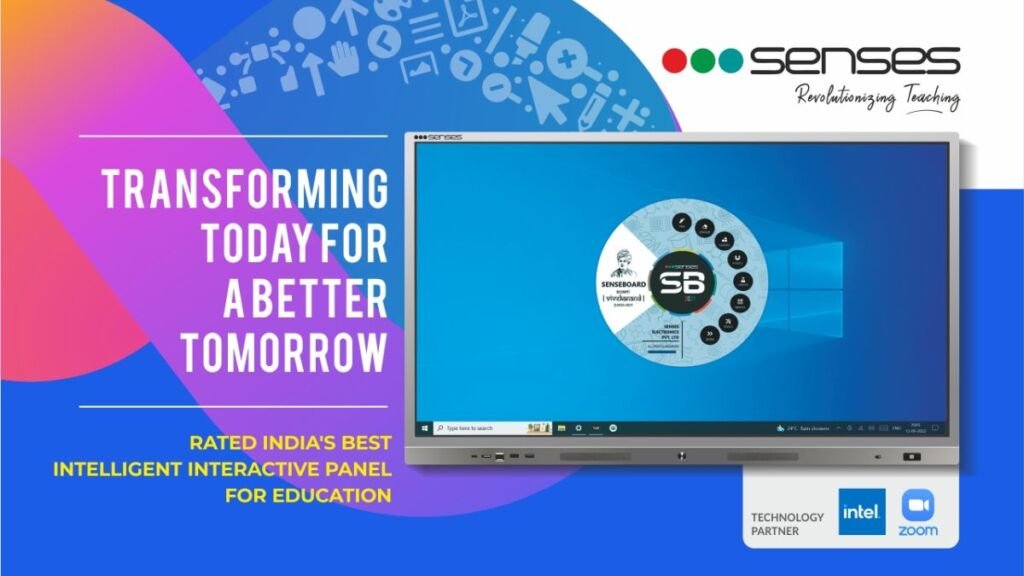
Pune (Maharashtra) [India], January 05: Teachers and educators have been trying to evolve classroom education for centuries. A little more than a decade ago, they replaced simple blackboards with projectors and screens that would use presentations and information from the internet as part of every educational session. Today, they are trying to take education a notch above with the help of LED interactive panels.
WHAT ARE INTERACTIVE PANELS?
Interactive panels are a user interface element that allows users to interact with a website or application by clicking on various buttons or links to access different content or features. They are often used to display a variety of information or options in a compact space and can be found on many websites and applications.
Interactive panels can be created using various web programming languages and frameworks, such as HTML, CSS, and JavaScript. They can be designed to display text, images, videos, or other types of media and can often be customized by the user to display only the content that is most relevant to them.
Some examples of interactive panels include:
- Navigation panels that allow users to navigate to different pages or sections of a website or application
- Information panels that display detailed information about a particular topic or item
- Control panels that allow users to adjust settings or preferences for a particular application or service
- Social media panels that display updates or notifications from social media platforms
- News feed panels display a stream of updates or articles from a particular source.
Overall, interactive panels are a useful tool for organizing and displaying information and options in a way that is easy for users to access and interact with.
HOW CAN THEY HELP EDUCATION?
Interactive panels can be a useful tool in education for a variety of reasons. Some ways in which they can help education include:
- Enhancing the learning experience: Interactive panels can be used to create engaging and interactive learning materials, such as quizzes, games, and simulations, which can help students retain information and stay motivated.
- Organizing information: Interactive panels can help educators present complex or detailed information in a clear and organized way, making it easier for students to understand and learn.
- Providing access to resources: Interactive panels can be used to provide students with access to a variety of learning resources, such as videos, readings, and other materials, which can help them deepen their understanding of a subject.
- Facilitating collaboration: Interactive panels can be used to create virtual classrooms or learning environments where students can collaborate and communicate with each other in real time, even if they are physically separated.
Overall, interactive panels can be a valuable tool for educators looking to create engaging and interactive learning experiences for their students.
WHAT MAKES SENSES THE NUMBER ONE CHOICE FOR EDUCATORS?
The interactive panels produced by Senses can enhance the educational experience by providing hands-on activities, sensory materials, and multimedia resources that engage students’ senses of touch, sight, and sound. This can make lessons more enjoyable and easier to remember.
They can also facilitate the process of learning new concepts and information by using visual aids, demonstrations, and hands-on activities that allow students to see, hear, and experience new ideas in a tangible way.
In addition, interactive panels can promote inclusivity and accessibility by offering visual aids, audio resources, and hands-on materials that cater to the diverse needs and learning styles of students. This can make education more accessible for those with different abilities or learning challenges.
Finally, these panels can help to create a more positive and stimulating learning environment by using colourful materials, music, and other sensory resources to create an engaging and pleasant atmosphere for both students and teachers.
But most importantly, Senses is popular because it uses educators’ feedback to improve their panels. It is important for companies that produce educational tools, such as Senses interactive panels, to listen to the feedback and needs of educators in order to improve and optimize their products. By gathering feedback from educators who use their interactive panels in the classroom, Senses can learn about the specific challenges and needs that educators face and can use this information to improve and enhance their products.
For example, if educators report that a particular feature of the interactive panels is not useful or is difficult to use, Senses can work to improve or remove that feature. Alternatively, if educators suggest a new feature or capability that they would like to see in the interactive panels, Senses can consider adding it in a future update.
Overall, by gathering feedback from educators and using it to guide product development, Senses can help to ensure that their interactive panels are as effective and useful as possible for educators and their students.
If you have any objection to this press release content, kindly contact pr.error.rectification[at]gmail.com to notify us. We will respond and rectify the situation in the next 24 hours.




